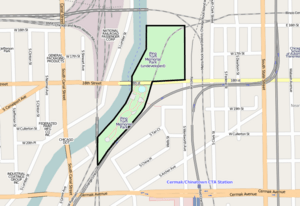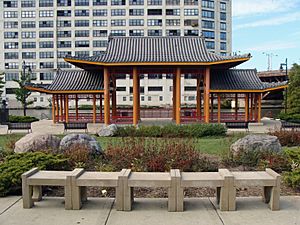Ping Tom Memorial Park facts for kids
Quick facts for kids Ping Tom Memorial Park |
|
|---|---|

Ping Tom Memorial Park's developed area
|
|

Map of Ping Tom Memorial Park
|
|
| Type | Public park |
| Location | Chinatown, Chicago |
| Area | 6.37 acres (25,800 m2) developed 10.87 acres (44,000 m2) undeveloped |
| Created | October 2, 1999 |
| Operated by | Chicago Park District |
| Status | Open all year |
| Website | Ping Tom Memorial Park |
| Ping Tom Memorial Park | |||||||||||
|---|---|---|---|---|---|---|---|---|---|---|---|
| Traditional Chinese | 譚繼平紀念公園 | ||||||||||
| Simplified Chinese | 谭继平纪念公园 | ||||||||||
|
|||||||||||
Ping Tom Memorial Park is a large public park in Chicago's Chinatown neighborhood. It covers about 17.24-acre (6.98 ha) and is managed by the Chicago Park District.
The park sits on the south bank of the Chicago River. It has cool features like a pagoda-style building, peaceful bamboo gardens, and a playground. The park is named after Ping Tom, an important businessman and leader in the Chinatown community. A bronze statue of him is near the park's main building. The park was built in different stages, starting in 1999 and adding new parts over the years.
Contents
Why Ping Tom Park Was Built
In 1962, two parks in the Chinatown area, Hardin Square and Stanford Park, were torn down to make way for the Dan Ryan Expressway. This left the community with very little green space. A small park, Sun Yat-sen Playlot Park, was created in the mid-1970s. However, people in Chinatown really wanted a much bigger park.
Ping Tom, a community leader, worked hard to get a new park built. In 1984, he started a company called the Chinese American Development Corporation. This company bought an old 32-acre (13 ha) train yard in 1989. They began building a big project called Chinatown Square on part of this land.
The Chicago Park District then bought about 6 acres (24,000 m2) of the unused land along the Chicago River in 1991. They also bought another 6 acres (24,000 m2) stretching north along the river. The community formed a group to work with the Park District to turn this area into a public park.
Building the Park
The southern part of the park area needed a lot of work. The river bank was fixed, and a special crossing was built over the train tracks. Construction started in 1998 and finished in the fall of 1999. The first part of the park cost $5 million and officially opened on October 2, 1999.
Park Expansion
In 2002, the Chicago Park District got an extra 5 acres (20,000 m2) of land next to the park's undeveloped northern part. This led to "Phase II" of the park's development, covering about 11 acres (45,000 m2) north of 18th Street. This expansion, finished in 2011, added more shoreline and ways to access the park.
In September 2009, a $10 million plan was approved to develop the 6-acre (24,000 m2) area along the Chicago River. This included building a retaining wall, creating fish habitats, and adding natural shoreline sections. Open lawns, landscaped areas, a fishing spot, and pathways were also developed.
The 18th Street bridge underpass was also improved, creating two plazas to connect the park further north. A plan for a new athletic field house was also approved, costing $10 million.
On September 19, 2011, Mayor Rahm Emanuel announced plans to build several boathouses along the Chicago River, including one at Ping Tom Memorial Park. The second phase of the park, north of the 18th Street bridge, was also designed by Site Design Group. It features a long boardwalk with red Chinese railings and special decorative limestone rocks called scholar's stones from China.
The boathouse officially opened on June 9, 2013.
The Fieldhouse
On October 14, 2013, Mayor Emanuel opened the Ping Tom Memorial Park Fieldhouse. This large 30,000 square feet (2,800 m2) building has a gym, a swimming pool, a fitness center, and meeting rooms. A "Yellow Crane" statue, a gift from Wuhan, China, was placed in the fieldhouse lobby.
A stainless steel sculpture called "Stone Talk" was donated by the city of Shanghai in 2015. It celebrates 30 years of friendship between Chicago and Shanghai. On October 10, 2015, the fieldhouse was renamed the Leonard M. Louie Fieldhouse. Louie started the Ping Tom Park Advisory Council and was a big supporter of the community.
Park Design and Features

Ernest C. Wong of Site Design Group designed Ping Tom Memorial Park. He knew the Chinatown community well and asked for their ideas for the park. The park's design uses pathways to connect different areas, making them feel like traditional Chinese courtyards.
A beautiful pagoda-style pavilion, inspired by a building in Suzhou, China, is a main feature. Its roof tiles came all the way from Japan. The park's entrance has the "Four Dragon Gateway," which are four 20 feet (6.1 m)-tall columns with Chinese dragons carved into them.
The park also has Chinese-inspired gardens with ginkgo trees and bamboo. Large granite rocks are placed around the park. There is also a children's playground at the north end.
Murals in the Park
The park features several colorful murals:
- On July 28, 2018, the "All As One" mural was dedicated. It's in the east plaza of the 18th Street bridge underpass and looks like blue and white Ming dynasty porcelain.
- On September 7, 2019, the "Between the Mountains and the Water" mural was dedicated in the west plaza. This mural is inspired by ancient Han dynasty silk landscape paintings.
- Also on that date, "Welcome to Ping Tom Memorial Park" and "Be Like Water" murals were added to a western support structure.
Fun Events at the Park
Ping Tom Memorial Park is a busy place with many exciting events:
- The Chicago Dragon Boat Race for Literacy happens every summer. Teams race dragon boats on the Chicago River. This event raises money for reading, culture, and diversity programs.
- The park is also the finish line for the Chicago River Flatwater Classic, an annual canoe and kayak race.
- In 2004, the Chinatown Chamber of Commerce hosted free movies and concerts.
- The Redmoon Theater performed an outdoor play called Sink. Sank. Sunk... at the park. This play used floating props in the river and even included the sounds of nearby trains.
- The final episode of the TV show The Amazing Race Season 6 ended at Ping Tom Memorial Park.
The park is also served by a water taxi operated by Wendella Boats. It's the southernmost stop, connecting the park to other parts of Chicago along the river.
Images for kids




